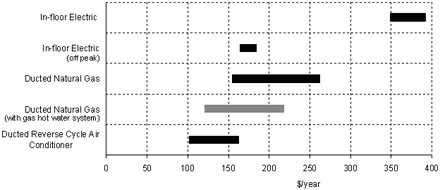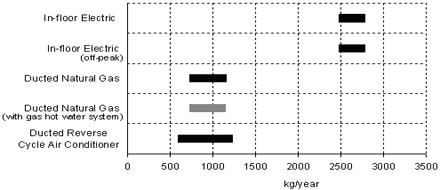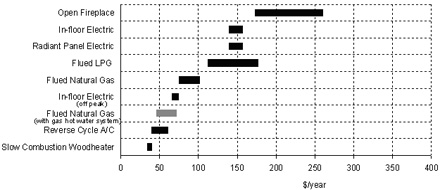What is Reverse Cycle Airconditioning?
Refrigerative air conditioners use the same operating principle as refrigerators, they "pump" heat from one place to another. Like refrigerators, they have two connected coils - an inside coil and outside coil. The coils are connected by pipes filled with refrigerant which is pumped around the circuit by a compressor. As warm air passes over the indoor coil, heat is transferred to the refrigerant passing through the coil and pumped to the outdoor coil where it is dissipated into the atmosphere. This is the reason why air conditioners are also called heat pumps.
Some refrigerative air conditioners also work in reverse to provide heat in winter. Rather than making their own heat from electricity, they use the electricity to pump heat from outside the building to inside. Even on fairly cold days, energy can still be extracted from the outside air and pumped inside.
Refrigerative systems dehumidify as well as cool the air. This feature makes them highly suitable for hot, humid climates like coastal regions.
Benefits of a reverse cycle air-conditioner
The most obvious benefit of Reverse cycle air-conditioners is that the one appliance can be used for heating and cooling.
One of the most efficient forms of heating is a reverse cycle air-conditioner particularly for Perth.
Reverse cycle air-conditioners combine refrigerative cooling, dehumidification and when running in reverse very efficient heating. With a Reverse cycle air-conditioner you have one unit providing the combined effects of both a home air-conditioner and a heater.
Other benefits include:
- quiet operation
- wall mounted so it is away from small hands
- Very precise climate control, a constant temperature (good for asthma sufferers, babies and the elderly)
- filtered, pollution-reduced air
- because there are no open flames, it's safe for families with children
- A reverse cycle air-conditioner works by transferring heat, making it more energy-efficient than normal electric heating. This not only helps our environment, but can also reduce your electricity bill.
Government Heating Cost Comparisons!
The graphs below provide approximate running costs and greenhouse gas emissions for different types of heaters in an average home with an insulated ceiling.
The costs and emissions are estimates only and will vary from location to location and with different types of use. It is intended that the graphs give an indication of the comparative costs between different types of heaters under similar conditions.
| CENTRAL HEATERS (150m² floor area) |
Approximate Annual Running Costs

Approximate Annual Greenhouse Gas Emissions

| SPACE HEATERS (60m² floor area) |
Approximate Annual Running Costs
Buying a reverse cycle air-conditioner
Think about the overall costs when choosing your cooling appliance. A unit with a higher purchase price and installation cost could deliver the lowest operating costs, making it cheaper in the long run.
Consider the following factors when making your choice:
- The energy star rating (the more stars, the more energy efficient).
- The size of the area to be cooled.
- The direction that your room faces, whether the room is insulated and the size of any windows in that room.
- The amount of time that you will use the appliance each day.
- The cost of the appliance.
- The cost of installing it.
- The running costs, usually expressed in terms of cents per energy unit used (kWh).
- How long you expect the appliance to last.
Overall, your air-conditioning specialist will be able to help you work out the right unit for your specific needs. It is important to note that purchase prices and installation costs vary according to different locations.
Appropriate system size is particularly important with refrigerative air conditioners as choosing a system that's too small won't provide effective cooling and choosing one that's too large will result in frequent cycling (turning on and off), wasting energy and money and increasing the system's wear and tear. An oversized system may also be less effective at dehumidifying the air.
Refrigerative air conditioners should be sized based on output capacity. The output is normally expressed in kilowatts (kW). If you're considering purchasing a room unit, an approximate base is to allow 0.125 kW per square metre of floor area to be cooled in living areas. This guide applies to standard 2.4 m high ceilings with insulation. As appropriate sizing depends on a number of other factors besides the area of room to be cooled, make sure you consult an air-conditioning specialist before purchasing your system. Your specialist will be able to give you a precise calculation of size based on your own specifications.
When sizing your system it is important not to confuse the output capacity with the input capacity or coefficient of performance (COP). The COP of an air conditioner indicates how many units of heat are removed by the air conditioner per unit of electricity consumed. For example, an air conditioner with a COP of 2.5 will pump 2.5 kWh of heat outside for every unit (kWh) of electricity used. Typically, COPs vary from a low of about 1.7 to a high of about 3.3 for domestic air conditioners. For air conditioners capable of heating, different COPs apply for the heating mode and are usually between 2.0 and 3.2. Air conditioners with a high COP for cooling do not necessarily have a high COP for heating, although this is often the case.
Types of Refrigerative Air Conditioning
Portable units
Small, portable units cool one room at a time and can be wheeled from room to room. A connection to the outside is required to remove the hot air. Some units can be placed in an open window so the hot coil is outside while other types have an internal hot coil and a flexible air hose which can be placed out a window or door.
Portable units offer very low efficiency and often struggle to cool an area, you will also find them ridiculously noisy.
Fixed or fascia units
Fixed units can cool larger areas and come in two main types - single units and split systems.
Single units (RAC's) are mounted through a wall or window with the hot coil on the outside and can only really cool the room in which they are situated. As the pumps and fans are all in one location, they can be quite noisy. They are old technology which can be hard to source now days.
Split systems (Split's) have the cool coil inside a room and all the other equipment located outdoors up to 20 metres away. This makes them much quieter indoors than RAC's.
Multi split systems can cool more than one open area with just a single outdoor unit, but they can carry similar constraints in regards to zoning as a ducted systems and can cost just as much to run. In general they are more expensive, however if you have limited roof space or restrictions on outdoor locations they may be a blessing.
Ducted systems
These systems can cool a whole house by supplying cool air to multiple outlets. A good system will have a zone arrangement so that cool air can be supplied to only those areas required (for example, living areas during the day and bedrooms at night). This can significantly reduce the amount of energy consumed.
Ducted systems can be roof or ground-mounted and are usually split type systems with the hot coil and fluid pumps outdoors and a cold coil situated inside the ducting. Typically air is drawn from inside the house and then cooled and recirculated. Some systems allow fresh air to be mixed with the recirculated air.
Take care as the unit itself is only around a third of the total cost. Make sure you are happy with the installation company, do the methods and components they use compare to the units quality. What about the design, plan the layout of ducts, thermostats, sensors, timers and other devices to get the best performance and efficiency from your system. Make sure these three are put together well on the day.
Can't find an answer, click here?
More Information - Tips on running your Air Con
The above information is available at:




